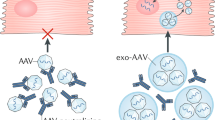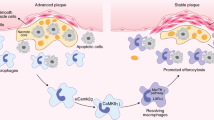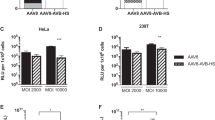Abstract
Targeted delivery of biological agents to atherosclerotic plaques may provide a novel treatment and/or useful tool for imaging of atherosclerosis in vivo. However, there are no known viral vectors that possess the desired tropism. Two plaque-targeting peptides, CAPGPSKSC (CAP) and CNHRYMQMC (CNH) were inserted into the capsid of adeno-associated virus 2 (AAV2) to assess vector retargeting. AAV2-CNH produced significantly higher levels of transduction than unmodified AAV2 in human, murine and rat endothelial cells, whereas transduction of nontarget HeLa cells was unaltered. Transduction studies and surface plasmon resonance suggest that AAV2-CNH uses membrane type 1 matrix metalloproteinase as a surface receptor. AAV2-CAP only produced higher levels of transduction in rat endothelial cells, possibly because the virus was found to be affected by proteasomal degradation. In vivo substantially higher levels of both peptide-modified AAV2 vectors was detected in the brachiocephalic artery (site of advanced atherosclerotic plaques) and aorta, whereas reduced levels were detected in all other organs examined. These results suggest that in the AAV2 platform the peptides are exposed on the capsid surface in a way that enables efficient receptor binding and so creates effective atherosclerotic plaque targeted vectors.
This is a preview of subscription content, access via your institution
Access options
Subscribe to this journal
Receive 12 print issues and online access
$259.00 per year
only $21.58 per issue
Buy this article
- Purchase on Springer Link
- Instant access to full article PDF
Prices may be subject to local taxes which are calculated during checkout







Similar content being viewed by others
References
de Nooijer R, von der Thusen JH, Jukema JW, van der Wall EE, van Berkel TJ, Baker AH et al. Lesional overexpression of matrix metalloproteinase-9 promotes intraplaque hemorrhage in advanced lesions but not at earlier stages of atherogenesis. Arterioscler Thromb Vasc Biol 2006; 26: 340–346.
Zadelaar ASM, von der Thusen JH, Boesten LSM, Hoeben RC, Kockx MM, Versnel MA et al. Increased vulnerability of pre-existing atherosclerosis in ApoE-deficient mice following adenovirus-mediated Fas ligand gene transfer. Atherosclerosis 2005; 183: 244–250.
Von Der Thursen JH, Kuiper J, Fekkes J, Fekkes ML, De Vos P, Van Berkel TJC et al. Attenuation of atherogenesis by systemic and local adenovirus-mediated gene transfer of interleukin-10 in LDLr−/− mice. FASEB J 2001; 15: 2730–2732.
Nicklin SA, Wu E, Nemerow GR, Baker AH . The influence of adenovirus fiber structure and function on vector development for gene therapy. Mol Ther 2005; 12: 384–393.
White S, Nicklin S, Buning H, Brosnan M, Leike K, Papadakis E et al. Targeted gene delivery to vascular tissue in vivo by tropism modified adeno-associated virus vectors. Circulation 2004; 109: 513–519.
Work LM, Buning H, Hunt E, Nicklin SA, Denby L, Britton N et al. Vascular bed-targeted in vivo gene delivery using tropism-modified adeno-associated viruses. Mol Ther 2006; 13: 683–693.
Nathwani AC, Davidoff A, Hanawa H, Zhou JF, Vanin EF, Nienhuis AW . Factors influencing in vivo transduction by recombinant adeno-associated viral vectors expressing the human factor IX cDNA. Blood 2001; 97: 1258–1265.
Koeberl DD, Alexander IE, Halbert CL, Russell DW, Miller AD . Persistent expression of human clotting factor IX from mouse liver after intravenous injection of adeno-associated virus vectors. Proc Natl Acad Sci USA 1997; 94: 1426–1431.
Summerford C, Samulski RJ . Membrane-associated heparan sulfate proteoglycan is a receptor for adeno-associated virus type 2 virions. J Virol 1998; 72: 1438–1445.
Girod A, Ried M, Wobus C, Lahm H, Leike K, Kleinschmidt J et al. Genetic capsid modifications allow efficient re-targeting of adeno-associated virus type 2. Nat Med 1999; 5: 1052–1056.
Nicklin SA, Buening H, Dishart KL, de Alwis M, Girod A, Hacker U et al. Efficient and selective AAV-2 mediated gene transfer directed to human vascular endothelial cells. Mol Ther 2001; 4: 174–181.
Work LM, Nicklin SA, Brain NJR, Dishart KL, Seggern DJV, Hallek M et al. Development of efficient viral vectors selective for vascular smooth muscle cells. Mol Ther 2004; 9: 198–208.
Liu C, Bhattacharjee G, Boisvert W, Dilley R, Edgington T . In vivo interrogation of the molecular display of atherosclerotic lesion surfaces. Am J Pathol 2003; 163: 1859–1870.
Kim Y, Lillo AM, Steiniger SCJ, Liu YL, Ballatore C, Anichini A et al. Targeting heat shock proteins on cancer cells: selection, characterization and cell-penetrating properties of a peptidic Grp78 ligand. Biochemistry 2006; 45: 9434–9444.
Delpino A, Castelli M . The 78 kDa glucose-regulated protein (GRP78/BiP) is expressed on the cell membrane, is released into cell culture medium and is also present in human peripheral circulation. Biosci Rep 2002; 22: 407–420.
Bhattacharjee G, Ahamed J, Pedersen B, El-Sheikh A, Mackman N, Ruf W et al. Regulation of tissue factor-mediated initiation of the coagulation cascade by cell surface Grp78. Arterioscler Thromb Vasc Biol 2005; 25: 1737–1743.
Outinen PA, Sood SK, Pfeifer SI, Pamidi S, Podor TJ, Li J et al. Homocysteine-induced endoplasmic reticulum stress and growth arrest leads to specific changes in gene expression in the development of atherosclerosis. Blood 1999; 94: 959–967.
Rajavashisth TB, Xu XP, Jovinge S, Meisel S, Xu XO, Chai NN et al. Membrane type 1 matrix metalloproteinase expression in human atherosclerotic plaques—evidence for activation by proinflammatory mediators. Circulation 1999; 99: 3103–3109.
Brown DL, Hibbs MS, Kearney M, Loushin C, Isner JM . Identification of 92-kD gelatinase in human coronary atherosclerotic lesions. Association of active enzyme synthesis with unstable angina. Circulation 1995; 91: 2125–2131.
Galis ZS, Sukhova GK, Lark MW, Libby P . Increased expression of matrix metalloproteinases and matrix degrading activity in vulnerable regions of human atherosclerotic plaques. J Clin Invest 1994; 94: 2493–2503.
Li Z, Li L, Zielke R, Cheng L, Xiao R, Crow MT et al. Increased expression of 72-kd type IV collagenase (MMP-2) in human aortic atherosclerotic lesions. Am J Pathol 1996; 148: 121–128.
Henney AM, Wakeley PR, Davies MJ, Foster K, Hembry R, Murphy G et al. Localization of stromelysin gene expression in atherosclerotic plaques by in situ hybridization. Proc Natl Acad Sci USA 1991; 88: 8154–8158.
Nikkari ST, Obrien KD, Ferguson M, Hatsukami T, Welgus HG, Alpers CE et al. Interstitial collagenase (MMP-1) expression in human carotid atherosclerosis. Circulation 1995; 92: 1393–1398.
Southgate KM, Fisher M, Banning AP, Thurston VJ, Baker AH, Fabunami RP et al. Upregulation of basement membrane-degrading metalloproteinase secretion after balloon injury of prig carotid arteries. Circ Res 1996; 79: 1177–1187.
Johnson J, George SJ, Newby AC, Jackson CL . Divergent effects of matrix metalloproteinases-3, -7, -9 and -12 on atherosclerotic plaque stability in mouse brachiocephalic arteries. Proc Natl Acad Sci USA 2005; 102: 15575–15580.
Chae H-J, Tyangt S-K, Kinm D-S, Kim H-M, Chae S-W, Keum K-S et al. Ge-Jee-Bok-Ryung-Hwan induces apoptosis in human cervical carcinoma HeLa cells—an endoplasmic reticulum stress pathway. Life Sci 2004; 75: 2997–3016.
Zhai Y, Hotary KB, Bosch FX, Munoz N, Weiss SJ, Cho KR . Expression of membrane type 1 matrix metalloproteinase is associated with cervical carcinoma progression and invasion. Cancer Res 2005; 65: 6543–6550.
Pajusola K, Gruchala M, Joch H, Luscher T, Yla-Herttuala S, Bueler H . Cell-type-specific characteristics modulate the transduction efficiency of adeno-associated virus type 2 and restrain infection of endothelial cells. J Virol 2002; 76: 11530–11540.
Atkinson SJ, Patterson ML, Butler MJ, Murphy G . Membrane type 1 matrix metalloproteinase and gelatinase A synergistically degrade type 1 collagen in a cell model. FEBS Lett 2001; 491: 222–226.
Douar AM, Poulard K, Stockholm D, Danos O . Intracellular trafficking of adeno-associated virus vectors: routing to the late endosomal compartment and proteasome degradation. J Virol 2001; 75: 1824–1833.
Duan D, Yue Y, Yan Z, Engelhardt JF . Endosomal processing limits gene transfer to polarised airway epithlelia by adneo-associated virus. J Clin Invest 2000; 105: 1573–1587.
Denby L, Nicklin SA, Baker AH . Adeno-associated virus (AAV)-7 and -8 poorly transduce vascular endothelial cells and are sensitive to proteasomal degradation. Gene Therapy 2005; 12: 1534–1538.
Johnson J, Jackson C . Atherosclerotic plaque rupture in the apolipoprotein E knockout mouse. Atherosclerosis 2001; 154: 399–406.
Xie Q, Bu W, Bhatia S, Hare J, Somasundaram T, Azzi A et al. The atomic structure of adeno-associated virus (AAV-2), a vector for human gene therapy. Proc Natl Acad Sci USA 2002; 99: 10405–10410.
Opie SR, Warrington Jr KH, Agbandje-McKenna M, Zolotukhin S, Muzyczka N . Identification of amino acid residues in the capsid proteins of adeno-associated virus type 2 that contribute to heparan sulfate proteoglycan binding. J Virol 2003; 77: 6995–7006.
Kern A, Schmidt K, Leder C, Muller OJ, Wobus CE, Bettinger K et al. Identification of a heparin-binding motif on adeno-associated virus type 2 capsids. J Virol 2003; 77: 11072–11081.
Perabo L, Goldnau D, White K, Endell J, Boucas J, Humme S et al. Heparan sulfate proteoglycan properties of adeno-associated virus retargeting mutants and consequences for their in vivo tropism. J Virol 2006; 80: 7265–7269.
Wu P, Xiao W, Conlon T, Hughes J, Agbandje-McKenna M, Ferkol T et al. Mutational analysis of the adeno-associated virus type 2 (AAV2) capsid gene and construction of AAV2 vectors with altered tropism. J Virol 2000; 74: 8635–8647.
Kim I-H, Jozkowicz A, Piedra PA, Oka K, Chan L . Lifetime correction of genetic deficiency in mice with a single injection of helper-dependent adenoviral vector. Proc Natl Acad Sci USA 2001; 98: 13282–13287.
Oka K, Pastore L, Kim I-H, Merched A, Nomura S, Lee H-J et al. Long-term stable correction of low-density lipoprotein receptor-deficient mice with a helper-dependent adenoviral vector expressing the very low-density lipoprotein receptor. Circulation 2001; 103: 1274–1281.
Nicklin SA, Von Seggern DJ, Work LM, Pek DCK, Dominiczak AF, Nemerow GR et al. Ablating adenovirus type 5 fiber-CAR binding and HI loop insertion of the SIGYPLP peptide generate an endothelial cell-selective adenovirus. Mol Ther 2001; 4: 534–542.
Butler GS, Butler MJ, Atkinson SJ, Will H, Tamura T, Van Westrum SS et al. The TIMP2 membrane type 1 metalloproteinase ‘receptor’ regulates the concentration and efficient activation of progelatinase A. A kinetic study. J Biol Chem 1998; 273: 871–880.
Acknowledgements
This work was supported by the Medical Research Council (AB), British Heart Foundation (AB), Center for Molecular Medicine of the University of Cologne (HB), the Deutsche Forschungsgemeinschaft (HB) and the BMBF (HB, HJ). We thank Richard Jude Samulski (University of North Carolina at Chapel Hill) for kindly providing pXX6.
Author information
Authors and Affiliations
Corresponding author
Rights and permissions
About this article
Cite this article
White, K., Büning, H., Kritz, A. et al. Engineering adeno-associated virus 2 vectors for targeted gene delivery to atherosclerotic lesions. Gene Ther 15, 443–451 (2008). https://doi.org/10.1038/sj.gt.3303077
Received:
Revised:
Accepted:
Published:
Issue Date:
DOI: https://doi.org/10.1038/sj.gt.3303077
Keywords
This article is cited by
-
Development of a dual hybrid AAV vector for endothelial-targeted expression of von Willebrand factor
Gene Therapy (2023)
-
Technological advances in the use of viral and non-viral vectors for delivering genetic and non-genetic cargos for cancer therapy
Drug Delivery and Translational Research (2023)
-
Promise of adeno-associated virus as a gene therapy vector for cardiovascular diseases
Heart Failure Reviews (2017)
-
Pulmonary Targeting of Adeno-associated Viral Vectors by Next-generation Sequencing-guided Screening of Random Capsid Displayed Peptide Libraries
Molecular Therapy (2016)
-
Treatment of multifocal breast cancer by systemic delivery of dual-targeted adeno-associated viral vectors
Gene Therapy (2015)



